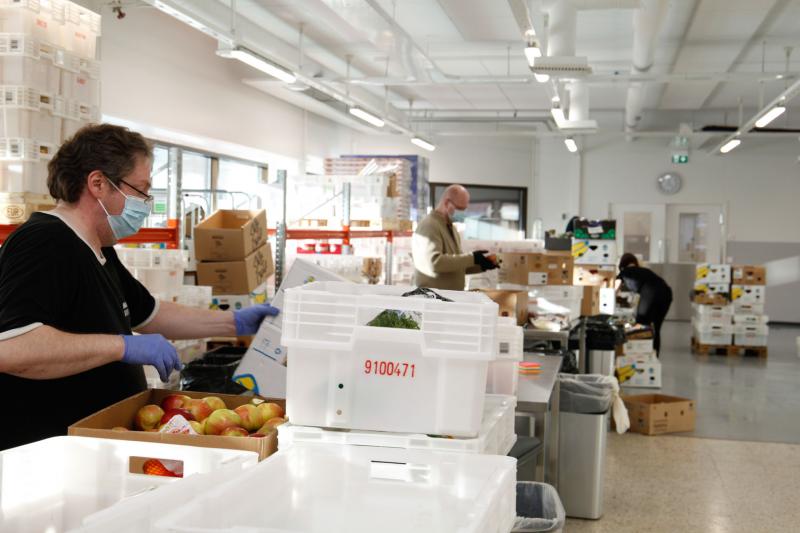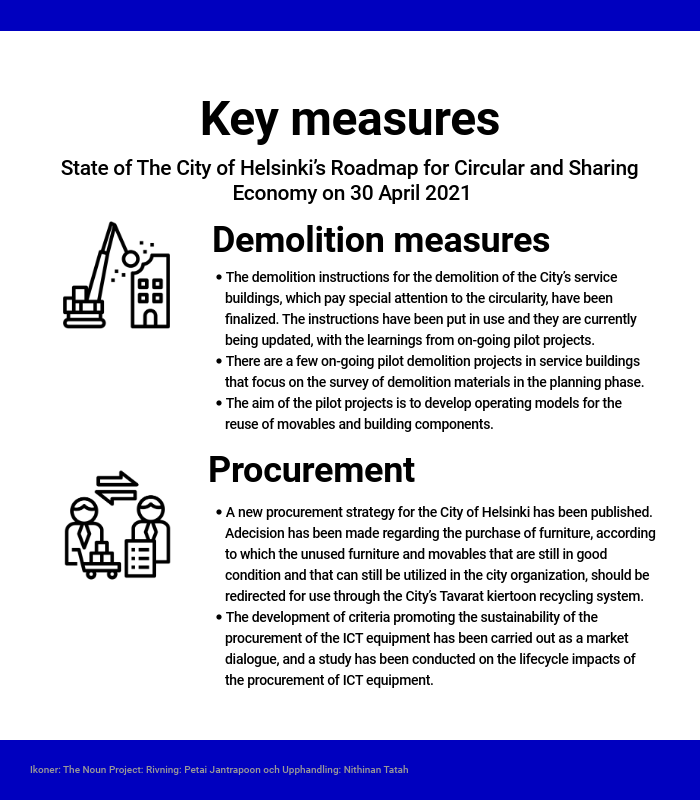Circular economy
As stated in Helsinki City Strategy for 2017–2021, the City’s goal is to implement emissions reductions and circular economy projects in Helsinki in cooperation with the corporate world and residents. The City of Helsinki’s Roadmap for Circular and Sharing Economy was approved in spring 2020. The roadmap’s focus areas are construction, procurements, green waste, the sharing economy and new business opportunities in the circular economy. The roadmap includes 31 concrete measures, and their implementation was launched in autumn 2020. A service for monitoring the measures, called Kiertotalousvahti (Circular Economy Watch), was published in December.
In autumn 2020, the mayor signed the European Circular Cities Declaration, which aims for a transition from a linear economy to a circular economy.
Demolition instructions were prepared for the City’s demolition projects
In 2020, demolition instructions that take the circular economy into account were completed for the demolition of the City’s service buildings. Two pilot sites focused on a demolition materials survey conducted in the planning phase were also launched. At two other demolition sites, a survey was conducted on the implementation of the reuse of movables and building components through the City’s reuse centres. The demolition instructions and demolition survey have also been piloted at demolition sites related to housing production. The guidance towards the reuse of building components is partly carried out in cooperation with Uusix workshops. In January 2020, a new construction project was launched with the purpose of raising and renovating apartment buildings to be energy-efficient by following circular economy principles.
Resource-efficient solutions were utilised actively in infrastructure construction
An action plan implementing the City of Helsinki’s principles of utilising excavated earth, rock material and demolition material has been actively put into service in several construction projects. In 2020, a total of 1,476,541 tonnes of excavated earth and rock material was used in the construction of public areas. Thanks to reuse, approximately EUR 8 million and 1,300,000 litres of fuel were saved, in addition to which emissions were reduced by 3,100 t CO2e. A database-based earth mass management tool was completed, allowing the transfer of masses based on data to be optimised, thereby reducing emissions and costs. The mass management tool will be linked through an open interface to the SeutuMassa database developed by the Helsinki Region Environmental Services Authority (HSY), among other things.
New resource-efficient solutions are continuously sought in infrastructure construction; between 2019 and 2020 an experimental land reclamation structure was built in Tritoninpuisto park in Jätkäsaari. It tested crushed concrete as fill material and the suitability of dynamic compaction for compacting fill located partly below sea level. In spring 2020, a stabilisation test was carried out in Kuninkaantammi on binders that are based on recycled materials.
Other material flows that form in infrastructure construction and that need their circulation to be enhanced have also been identified in Helsinki. These material flows include green waste that forms in the management of public areas as well as paving stones left over from construction sites, for example. Stara manufactures recycled substrate products in the Kivikko processing field and the Tali soil farm, using topsoil originating from the City’s worksites and composted green waste. Recycled substrates are utilised in the City’s own construction sites. In 2020, an integrated operating model plan was prepared for the production of recycled substrates at the processing locations in Kivikko and Tali. Additionally, a working group was set up for the City in 2020 and tasked with creating an operating model for the reuse of recycled paving stones. Stara also has an ongoing pilot that is testing the suitability of reeds as mulch material in parks. Reeds are gathered away from the city’s shores to prevent eutrophication.
Circular economy ecosystems were strengthened in the CircVol project
Helsinki participated in the CircVol project (August 2018 to December 2020) of the Six City Strategy. The purpose of the project was to promote business activities that follow circular economy principles and the utilisation of earth masses and large-volume industrial side streams. The Helsinki sub-project mapped large-volume biomasses and bio-based side streams in the Helsinki region, prepared a recommendation for the City’s operating model in strengthening the industrial and urban symbioses of the bioeconomy and circular economy, and developed tools to promote the circular economy in city planning. Envisioning the future, the project profiled areas such as existing industrial areas from the perspective of circular economy business potential, in addition to compiling a training package for land use planners.
The reduction of food waste and the utilisation of edible leftover food were enhanced
The City of Helsinki Service Centre has carried out a great amount of development work to reduce food waste. One important factor has been the examination of the entire supply chain, from the planning of menus and logistics to storage and serving. In 2020, causes of food waste were identified at different points of the food preparation chain, and solutions were considered for developing the operations.
The City of Helsinki Service Centre has developed its food waste monitoring systems, and in autumn 2020 schools adopted a software-based solution. The use of the monitoring system was expanded to other sites in early 2021. Another area focused on in 2020 was communications and pupil participation. During Food Waste Week, pupils weighed the uneaten food left on plates and recorded the daily numbers on a poster on the wall of the school restaurant. Menus and the selection of food are developed in active cooperation with City divisions. At schools, pupils can also influence meal-related matters through the schools’ restaurant committees.
In addition to the reduction of food waste, new ways of utilising edible leftover food are being developed. Some locations allow leftover food to be purchased after serving has ended, in addition to which leftover food is regularly donated to the parish and other third sector operators for food aid.
In 2020, the City of Helsinki and Parish Union of Helsinki partnered to establish the Stadin safka food waste terminal in Tapulikaupunki. The food waste terminal allows the leftover food of the trade industry, wholesalers and the food industry to be utilised more efficiently, widely and professionally through food aid. The food waste terminal started operating in December 2020. At the end of the year, Stadin safka was picking up food waste from approximately 30 stores or wholesalers as well as locations of the City of Helsinki Service Centre. Leftover food was delivered to approximately 30 food aid operators around Helsinki. Stadin safka also participated as a partner in an experimental project funded by the Ministry of the Environment that piloted the utilisation of schools’ leftover vegetarian food as a resource for the local communities.

Additionally, a survey was conducted in 2020 regarding barriers to and opportunities in the utilisation of leftover food within the City of Helsinki. The need for the survey came to light through the eco-supporters working in the City’s early childhood education in particular.
The City developed the reuse of its own movables
Management of the City’s own movables and the promotion of their reuse are continuously being developed. New instructions on the handling of the City’s unused movables and assets came into force in March 2020. The instructions instruct the City’s Tavarat kiertoon recycling system to be used in making unused furniture and movables available to other operators of the City, among other things.
Eyes on the future
Circular economy thinking is continuously increasing in Helsinki. The European Circular Cities Declaration provides a vision of what a circular city is and defines the direction which the Declaration’s signatories commit to take. This is supported for its part by the national Strategic Programme for Circular Economy and the City’s Roadmap for Circular and Sharing Economy, the implementation of which is already well underway. Through experiments and pilots, the objective is to find good circular economy practices that can be implemented as part of the City’s operations. Achieving the objectives requires a significant focus on communications and cooperation, both between City divisions and with companies, residents and other interest groups.
State of Helsinki’s circular and sharing economy measures on 30 April 2020

